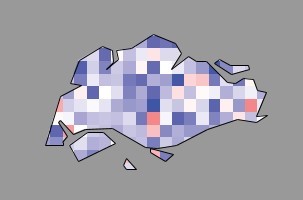Peptide-membrane interactions
Here we directly look at membrane dynamics which is used as a matric for the peptide induced membrane deformation. This approach helped us to decode a time and concentration dependent interaction of monomeric human islet amyloid polypeptide (hIAPP) with model and live cell membranes. In particular, we were able to show the temporal evolution of membrane dynamics after hIAPP addition [19] as a time lapse ‘FCS movie’ which allows one to directly visualize concerted spatial change in membrane diffusion with pixel resolution. ‘FCS movies’, to the best of our knowledge, is the first demonstration of time lapse diffusion imaging. We are currently applying this method to assay the action of other peptides and other model AMPs.

hIAPP FCS movie
Reference
[1] Li, P.; Wohland, T.; Ho, B.; Ding, J.L. Perturbation of lipopolysaccharide (LPS) micelles by Sushi 3 (S3) antimicrobial peptide
[2] Yu, L.; Bow, H.; Ding, J.L.; Wohland, T. Measuring the binding of an antimicrobial peptide with LPS by Fluorescence Correlation Spectroscopy, J. Teknologi F, 41 (2004) 101-112.
[3] Yu, L.; Ding, J.L.; Ho, B.; Wohland, T. Investigation of a novel artificial antimicrobial peptide by fluorescence correlation spectroscopy: an amphipathic cationic pattern is sufficient for selective binding to bacterial type membranes and antimicrobial activity, Biochim Biophys Acta, 1716 (2005) 29-39.
[4] Li, P.; Sun, M.; Wohland, T.; Ho, B.; Ding, J.L. The molecular mechanism of interaction between sushi peptide and pseudomonas endotoxin, Cell Mol Immunol, 3 (2006) 21-28.
[5] Li, P.; Sun, M.; Wohland, T.; Yang, D.W.; Ho, B.; Ding, J.L. Molecular mechanisms that govern the specificity of sushi peptides for gram-negative bacterial membrane lipids, Biochemistry, 45 (2006) 10554-10562.
[6] Yu, L.L.; Tan, M.Y.; Ho, B.; Ding, J.L.; Wohland, T. Determination of critical micelle concentrations and aggregation numbers by fluorescence correlation spectroscopy: Aggregation of a lipopolysaccharide, Analytica Chimica Acta, 556 (2006) 216-225.
[7] Yu, L.; Ding, J.L.; Ho, B.; Feng, S.S.; Wohland, T. Investigation of the mechanisms of antimicrobial peptides interacting with membranes by fluorescence correlation spectroscopy, The Open Chemical Physics Journal, 1 (2008) 62-79.
[8] Hebbar, S.; Lee, E.; Manna, M.; Steinert, S.; Kumar, G.S.; Wenk, M.; Wohland, T.; Kraut, R. A fluorescent sphingolipid binding domain peptide probe interacts with sphingolipids and cholesterol-dependent raft domains, J Lipid Res, 49 (2008) 1077-1089.
[9] Ang, P.K.; Loh, K.P.; Wohland, T.; Nesladek, M.; Van Hove, E. Supported lipid bilayer on nanocrystalline diamond: dual optical and field-effect sensor for membrane disruption, Adv Funct Mater, 19 (2009) 109-116.
[10] Leptihn, S.; Har, J.Y.; Chen, J.; Ho, B.; Wohland, T.; Ding, J.L. Single molecule resolution of the antimicrobial action of quantum dot-labeled sushi peptide on live bacteria, BMC Biol, 7 (2009) 22.
[11] Olaru, A.; Gheorghiu, M.; David, S.; Wohland, T.; Gheorghiu, E. Assessment of the multiphase interaction between a membrane disrupting peptide and a lipid membrane, J. Phys. Chem. B, 113 (2009) 14369-14380.
[12] Yu, L.; Guo, L.; Ding, J.L.; Ho, B.; Feng, S.S.; Popplewell, J.; Swann, M.; Wohland, T. Interaction of an artificial antimicrobial peptide with lipid membranes, Biochim Biophys Acta, 1788 (2009) 333-344.
[13] Zhang, D.; Manna, M.; Wohland, T.; Kraut, R. Alternate raft pathways cooperate to mediate slow diffusion and efficient uptake of a sphingolipid tracer to degradative and recycling compartments, J Cell Sci, (2009).
[14] Sankaran, J.; Manna, M.; Guo, L.; Kraut, R.; Wohland, T. Diffusion, transport, and cell membrane organization investigated by imaging fluorescence cross-correlation spectroscopy, Biophys J, 97 (2009) 2630-2639.
[15] Leptihn, S.; Har, J.Y.; Wohland, T.; Ding, J.L. Correlation of charge, hydrophobicity, and structure with antimicrobial activity of S1 and MIRIAM peptides, Biochemistry, 49 (2010) 9161-9170.
[16] Zhou, L.; Liu, S.P.; Chen, L.Y.; Li, J.; Ong, L.B.; Guo, L.; Wohland, T.; Tang, C.C.; Lakshminarayanan, R,; Mavinahalli, J.; Verma, C.; Beuerman, R.W. The structural parameters for antimicrobial activity, human epithelial cell cytotoxicity and killing mechanism of synthetic monomer and dimer analogues derived from hBD3 C-terminal region, Amino Acids, 40 (2010) 123-133.
[17] Kraut, R.; Bag, N.; Wohland, T. Fluorescence Correlation Methods for Imaging Cellular Behavior of Sphingolipid-Interacting Probes Methods in Cell Biology 108 (2012) 395-427.
[18] Kay, J.G.; Koivusalo, M.; Ma, X.; Wohland, T.; Grinstein, S. Phosphatidylserine dynamics in cellular membranes, Mol Bio Cell 23 (11) (2012) 2198-2212.
[19] Bag, N; Ali, A; Chauhan, VS; Wohland, T; Mishra, A. Membrane destabilization by monomeric hIAPP observed by imaging fluorescence correlation spectroscopy, Chem Commun (Camb). 49 (80) (2013) 9155-7.
[20] Huang S, Lim SY, Gupta A, Bag N, Wohland T. Plasma membrane organization and dynamics is probe and cell line dependent. Biochim Biophys Acta. 2017 Sep;1859(9 Pt A):1483-1492
[21] Niu L, Wohland T, Knoll W, Köper I. Interaction of a synthetic antimicrobial peptide with a model bilayer platform mimicking bacterial membranes. Biointerphases. 2017 Aug 31;12(4):04E404
[22] Ng J, Kamm RD, Wohland T, Kraut RS. Evidence from ITIR-FCS Diffusion Studies that the Amyloid-Beta (Aβ) Peptide Does Not Perturb Plasma Membrane Fluidity in Neuronal Cells. J Mol Biol. 2018 May 7. pii: S0022-2836(18)30340-1. doi: 10.1016/j.jmb.2018.04.030.
[23] Marzinek JK, Bag N, Huber RG, Holdbrook DA, Wohland T, Verma CS, Bond PJ. A Funneled Conformational Landscape Governs Flavivirus Fusion Peptide Interaction with Lipid Membranes. J Chem Theory Comput. 2018 Jun 6. doi: 10.1021/acs.jctc.8b00438.

